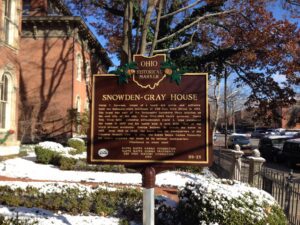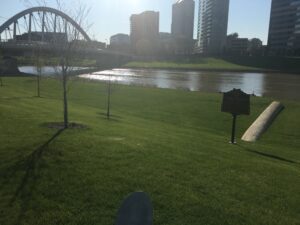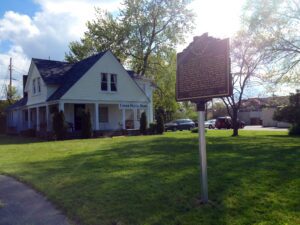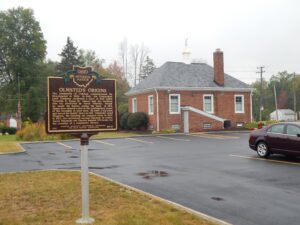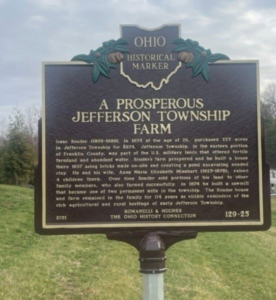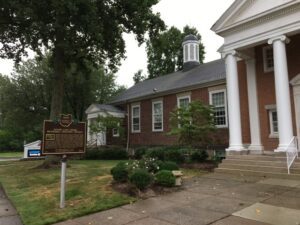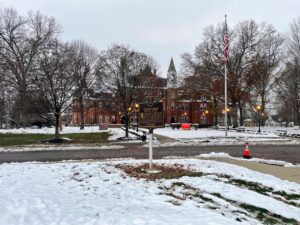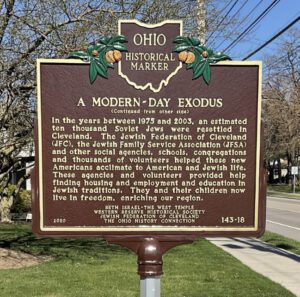, OH
Philip T. Snowden, owner of a fancy dry goods and millinery, built the Italianate-style residence at 530 East Town Street in 1852. The house was part of the fashionable University Place addition on the east side of the city. From 1862-1864 Ohio’s governor, David Tod, lived here. Columbus philanthropist David S. Gray purchased the house in 1870 and his family held it until 1922. One of the city’s premier architects, George Bellows, Sr. rebuilt the house in 1872. From 1923 to 1940, the house was the headquarters of the Columbus Women’s Club. In 1951, the Kappa Kappa Gamma fraternity for women acquired the house as its national headquarters. (Continued on other side)
, OH
The historic district extends from the former Main Street Bridge to Long Street and encompasses the public buildings on either side of the Scioto River. The 580 foot long low-head concrete arch Main Street Dam was constructed in 1918 in response to the catastrophic 1913 flood. The dam helped reshape the Downtown Columbus Scioto River basin into a reflecting pool for the monumental riverfront buildings of teh Civic Center, which were influenced by the City Beautiful movement of the 1890s and early 1900s. Nearly a century after its construction, however, the dam had contributed to an unhealthy environment for aquatic life and was removed in late 2013 as part of teh Scioto Greenways river restoration project.
, OH
With work inspired by mythology, literature, religion and nature, Cowan Pottery played a significant role in the formative years of American ceramic art and established a national following with products sold in fine department stores. The design studio, factory and showroom of Cowan Pottery stood here from 1920-1931. R. Guy Cowan moved the business to Rocky River from Lakewood, where it started in 1913. Although Cowan Pottery closed during the Depression, the firm’s work is still collected and can be found in the Smithsonian, Cleveland Museum of Art and other museums. Comprehensive holdings are in the Cowan Pottery Museum at the Rocky River Public Library.
, OH
The community of Olmsted commemorated its bicentennial in 2014. In 1795, the Connecticut Land Company auctioned a tract of land called Township 6, Range 15. Almost half the northern side was purchased by Aaron Olmsted, though he would die before seeing the land. In 1814, James Geer cleared a plot in the southeastern corner of the township to grow corn. He built a log house and moved his family there. Originally called Kingston, the township was renamed Lenox in 1823. In 1829, the settlement became Olmsted; in return, Aaron Olmsted’s son Charles donated 500 books for the creation of a community library.
, OH
Isaac Souder (1809-1889), in 1835 at the age of 26, purchased 225 acres in Jefferson Township for $674. Jefferson Township, in the eastern portion of Franklin County, was part of the U.S. military lands that offered fertile farmland and abundant water. Souder’s farm prospered and he built a house there 1837 using bricks made on-site and creating a pond excavating needed clay. He and his wife, Anna Maria Elizabeth Minehart (1825-1878), raised 4 children there. Over time Souder sold portions of his land to other family members, who also farmed successfully. In 1874 he built a sawmill that became one of two permanent mills in the township. The Souder house and farm remained in the family for 114 years as visible reminders of the rich agricultural and rural heritage of early Jefferson Township.
, OH
Elizabeth Tyron Sadler started the Methodist Episcopal Church in North Dover Township in June 1827, on land owned by her father-in-law Christopher Sadler. Charter members were the Rev. Eliphalet and Mrs. Margaret Johnson and their daughter Rebecca, along with niece Catherine Porter Foote. Elizabeth and William Sadler donated the land and much of the material needed to build a new wood-frame church here in 1841. The still-growing congregation built a brick church in 1908 and added a new sanctuary in 1955. Taking the name Bay United Methodist Church in 1968, the church has remained a center of community life and faith continuously since 1827. Family names associated with the church’s early decades include Aldrich, Cahoon, Drake, Foote, Osborn, Powell, Sadler, Tuttle, and Wolf.
, OH
Benjamin Russel Hanby (1833-1867) enrolled at Otterbein University in 1849. To afford tuition and to aid his family, Hanby alternated college terms with teaching in nearby public schools. While a student in 1856, he was moved by the story of a slave and his sweetheart to compose the anti-slavery ballad “Darling Nelly Gray.” The song quickly proved popular in abolitionist circles. After graduation, Hanby worked as an Otterbein agent, educator, United Brethren minister, and compiler and publisher for Chicago’s Root & Cady music house. He composed “Up on the Housetop” in 1864 while leading a New Paris singing school. During his short life, Hanby composed 80 songs, including the internationally-known hymn “Who is He in Yonder Stall.” Benjamin Hanby died of tuberculosis on March 16, 1867. He is buried in Otterbein Cemetery.
, OH
Here in 1963 congregants of Beth Israel-The West Temple, led by Louis Rosenblum, Herb Caron, and Rabbi Daniel Litt, founded the Cleveland Committee (later Council) on Soviet Anti-Semitism, the first American organization created to advocate for freedom for Soviet Jews. In 1970 this work led to the formation of the Union of Councils for Soviet Jews (UCSJ) under the leadership of Louis Rosenblum. The UCSJ, whose national office was located here 1970-1973, became the largest independent Soviet Jewry organization in the world. By the turn of the 21st century, the efforts begun here helped 1.6 million Jews leave the former Soviet Union. (Continued on other side)


